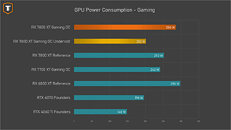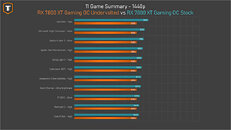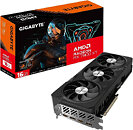T0@st
News Editor
- Joined
- Mar 7, 2023
- Messages
- 2,077 (3.16/day)
- Location
- South East, UK
Techtesters, a Dutch online publication and YouTube channel, took the time to investigate whether AMD's Radeon RX 7800 XT 16 GB GPU can compete with NVIDIA's GeForce RTX 4070 12 GB GPU in power efficiency stakes. Naturally, Team Red loses with their new mid-ranger running under normal conditions when lined up against its main rival - ranging from 252 W to 286 W versus 200 W (sometimes 196 W during gaming sessions) respectively. Nada Overbeeke (of Techtesters) chose to set a 90% power limit for their main subject matter—Gigabyte's custom design Navi 32-based Gaming OC model—through AMD software adjustments.
Its "aggressive" 200 W undervolted state was compared to stock performance in a number of modern game environments (refer to the charts below). The Gigabyte RX 7800 XT Gaming OC—using stock settings—consumed around 40% more power while managing only a 9% performance increase over its 200 W undervolted guise. VideoCardz notes that AMD's reference model requires 24% more power at stock: "As mentioned, a 9% performance boost should not be underestimated, but the substantial reduction in power consumption also resulted in quieter GPU operation and lower temperatures." It would have been interesting to see Techtesters undervolt their RTX 4070 FE candidate as well, but emphasis seemed to be placed on the newer card.




The VideoCardz verdict stated: "More importantly, even with a 200 W configuration, the card managed to hold its own against the RTX 4070, which consumed roughly the same amount of power at stock settings. This essentially means that there's virtually no difference between these GPUs once the RX 7800 XT is undervolted. Naturally, the choice between the two cards will heavily depend on the specific games chosen to play, as not everyone is comfortable with undervolting or altering GPU settings."
Undervolting the AMD Radeon RX 7800 XT all the way down to RTX 4070 levels :
The Techtesters rig:


View at TechPowerUp Main Site | Source
Its "aggressive" 200 W undervolted state was compared to stock performance in a number of modern game environments (refer to the charts below). The Gigabyte RX 7800 XT Gaming OC—using stock settings—consumed around 40% more power while managing only a 9% performance increase over its 200 W undervolted guise. VideoCardz notes that AMD's reference model requires 24% more power at stock: "As mentioned, a 9% performance boost should not be underestimated, but the substantial reduction in power consumption also resulted in quieter GPU operation and lower temperatures." It would have been interesting to see Techtesters undervolt their RTX 4070 FE candidate as well, but emphasis seemed to be placed on the newer card.




The VideoCardz verdict stated: "More importantly, even with a 200 W configuration, the card managed to hold its own against the RTX 4070, which consumed roughly the same amount of power at stock settings. This essentially means that there's virtually no difference between these GPUs once the RX 7800 XT is undervolted. Naturally, the choice between the two cards will heavily depend on the specific games chosen to play, as not everyone is comfortable with undervolting or altering GPU settings."
Undervolting the AMD Radeon RX 7800 XT all the way down to RTX 4070 levels :
The Techtesters rig:
- CPU: Intel Core i9-13900K
- Motherboard: ASUS ROG Maximus Z790 HERO
- Memory: 32 GB Corsair Vengeance RGB DDR5-6000 (2x16)
- Cooling: Corsair H150i Elite LCD
- PSU: Seasonic Prime TX 1600 Watt
- OS: Windows 11 PRO 22H2
- XMP Setting Applied: Resizable Bar Enabled
- Core Isolation is disabled


View at TechPowerUp Main Site | Source








 They underclock way better and don't have downclock problems in low/mid power stages. They're also scaling better with capped frames than the 7000 Series.
They underclock way better and don't have downclock problems in low/mid power stages. They're also scaling better with capped frames than the 7000 Series.